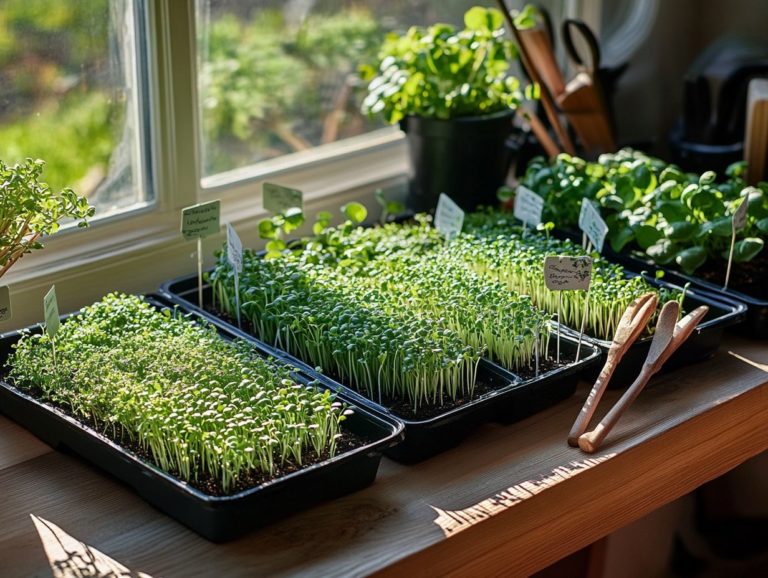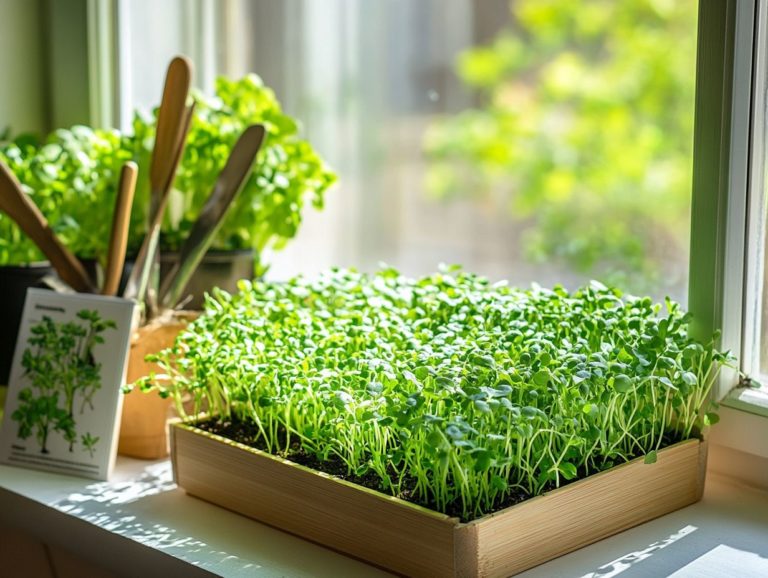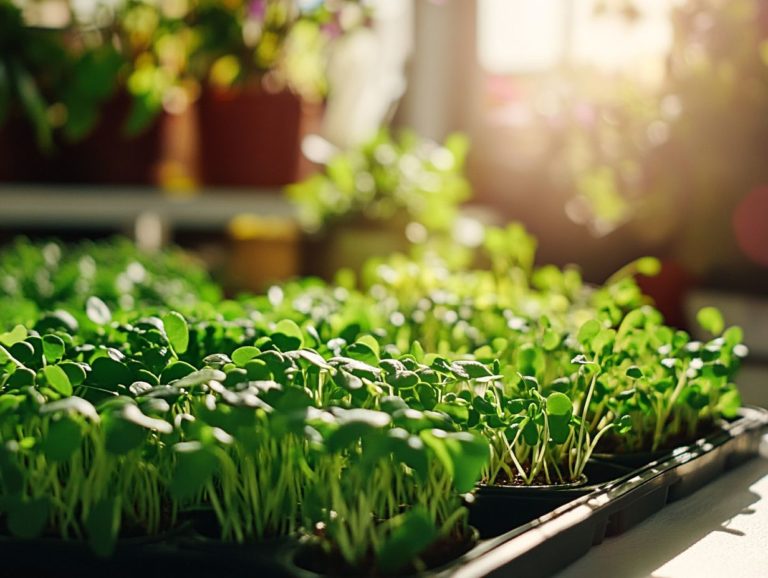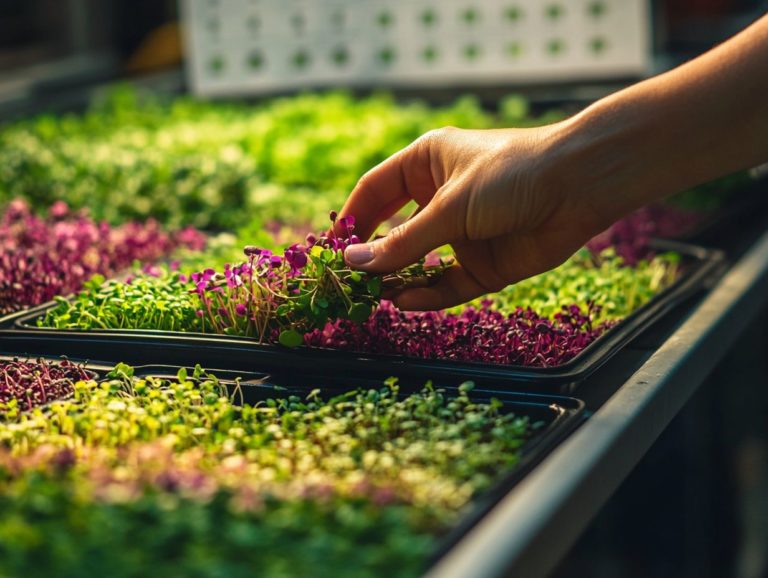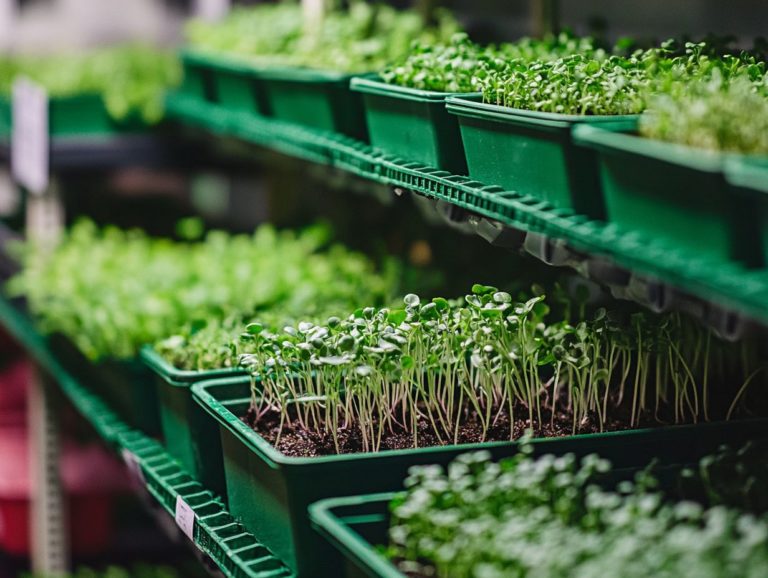5 Creative Ways to Grow Microgreens
Microgreens have truly taken the culinary scene by storm, presenting an exciting explosion of flavor, color, and nutrition all in compact little packages.
Whether you re a seasoned gardener or just dipping your toes into the world of gardening, cultivating these tiny greens can be a rewarding journey, especially for those interested in home gardening.
Explore five innovative ways to grow microgreens, from using recycled containers to setting up your very own vertical garden, including the use of a microgreens kit for easy setup.
Uncover the myriad health benefits of these vibrant plants and learn how to seamlessly incorporate them into your dishes or even market them locally as prebiotic foods.
Dive in and discover the remarkable potential of microgreens in both your kitchen and community!
Contents
Key Takeaways:
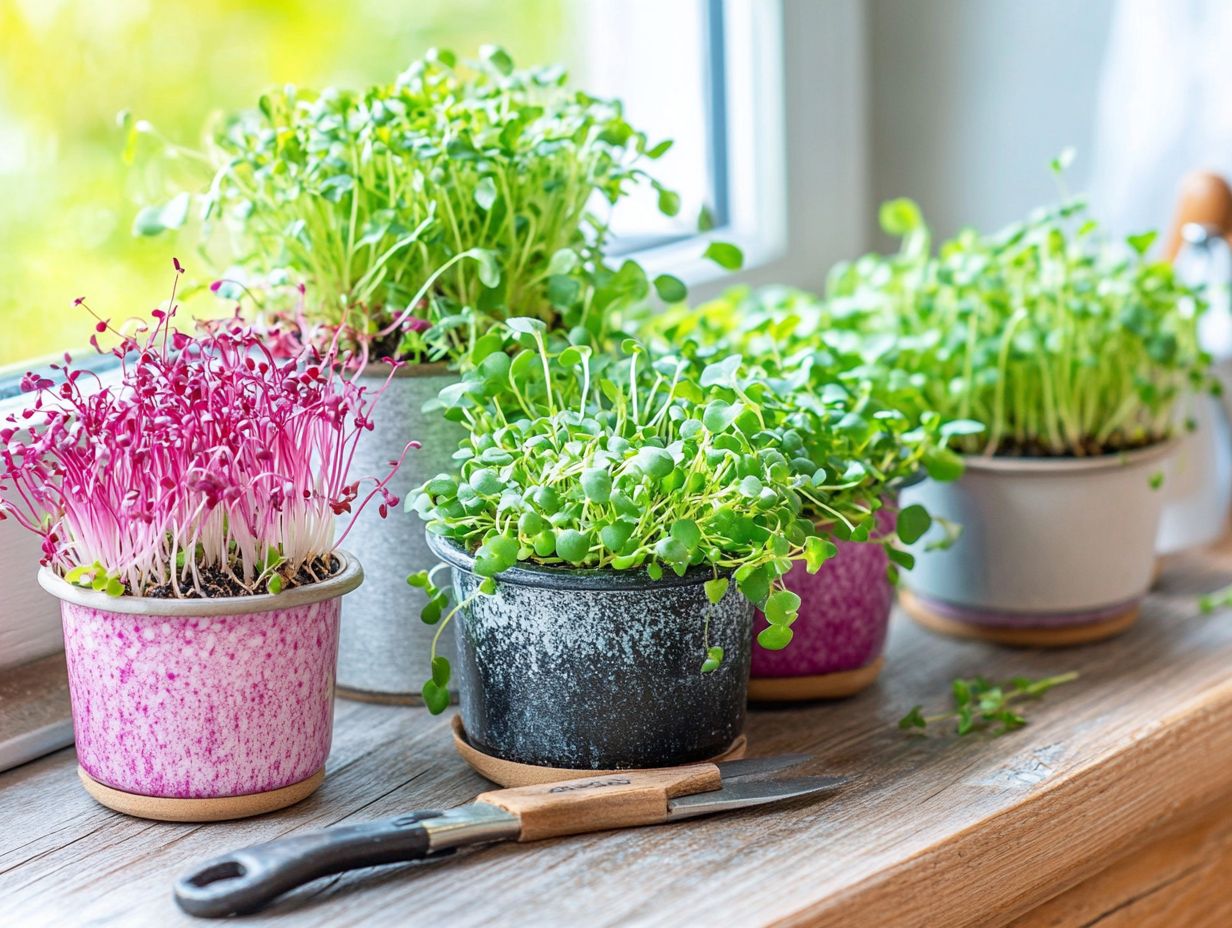
- Turn old containers into vibrant gardens! This eco-friendly choice saves you money.
- Maximize your space with wall or hanging gardens. It s a beautiful way to grow.
- Try different seeds to discover your favorites, like radish and sunflower.
1. Use Recycled Containers
Using recycled containers for growing microgreens is not only an eco-friendly choice but also a savvy, cost-effective strategy for your home gardening endeavors. You have the opportunity to transform everyday items into functional planting vessels, all while championing sustainability and reducing waste.
Consider the array of recycled containers at your disposal, such as plastic trays, glass jars, and even cardboard boxes, each bringing its own unique advantages. For example, plastic trays can provide excellent drainage when you punch holes in the bottom, ensuring your plants don t drown. Glass jars, on the other hand, add a charming aesthetic, making them perfect for displaying on your kitchen counter.
And let’s not overlook cardboard boxes; with a bit of wax paper, they can be adapted for moisture resistance.
As you prepare these containers, keep drainage in mind proper water flow is crucial for preventing root rot. Opt for a suitable soil medium, like a lightweight seed-starting mix, to create optimal growth conditions. This approach allows your microgreens to thrive with minimal effort, rewarding you with lush greens and supporting your weight management goals in no time.
2. Create a Vertical Garden
Creating a vertical garden is a brilliant way to maximize your indoor gardening space. A vertical garden grows upward, using walls or shelves instead of the ground. This allows you to grow microgreens like broccoli sprouts and radishes, which are known for their health benefits, in a compact area while elevating your living environment.
This approach conserves valuable floor space and presents a stunning visual display that can infuse any room with vibrancy. You ll find various vertical gardening systems at your disposal, from wall planters to tiered shelving, offering versatile options for cultivating fresh greens.
By incorporating these systems, you can ensure optimal light exposure and airflow for your microgreens, improving their overall nutritional value. These tiny powerhouses are brimming with nutrients and antioxidants, making them an excellent addition to your daily meals. Adding microgreens to your diet can boost your health and wellbeing, supporting immune function while delivering a burst of flavor without the extra calories.
3. Experiment with Different Seeds
Experimenting with different sprouting seeds is a truly rewarding journey in growing microgreens, making them an exciting option for anyone interested in plant-based nutrition. This exploration enriches your diet with a variety of nutrient-dense options, such as arugula, kale, and basil.
By diving into seeds like cilantro, chia, and amaranth, you can elevate your meals with their distinct tastes, enhancing both nutrition and your culinary experience. When selecting seeds, it s essential to consider their germination times and light requirements; some thrive in lower lighting, while others bask in brighter conditions.
Paying close attention to soil quality and moisture levels will help nurture these tiny greens to their fullest potential. Ultimately, integrating such diverse microgreens into your dishes not only adds complexity to flavors but also boosts the vitamins, minerals, and antioxidants in your daily meals.
Start your microgreens journey today and enjoy the fresh, nutritious flavors they bring to your meals!
4. Incorporate Microgreens into Your Cooking
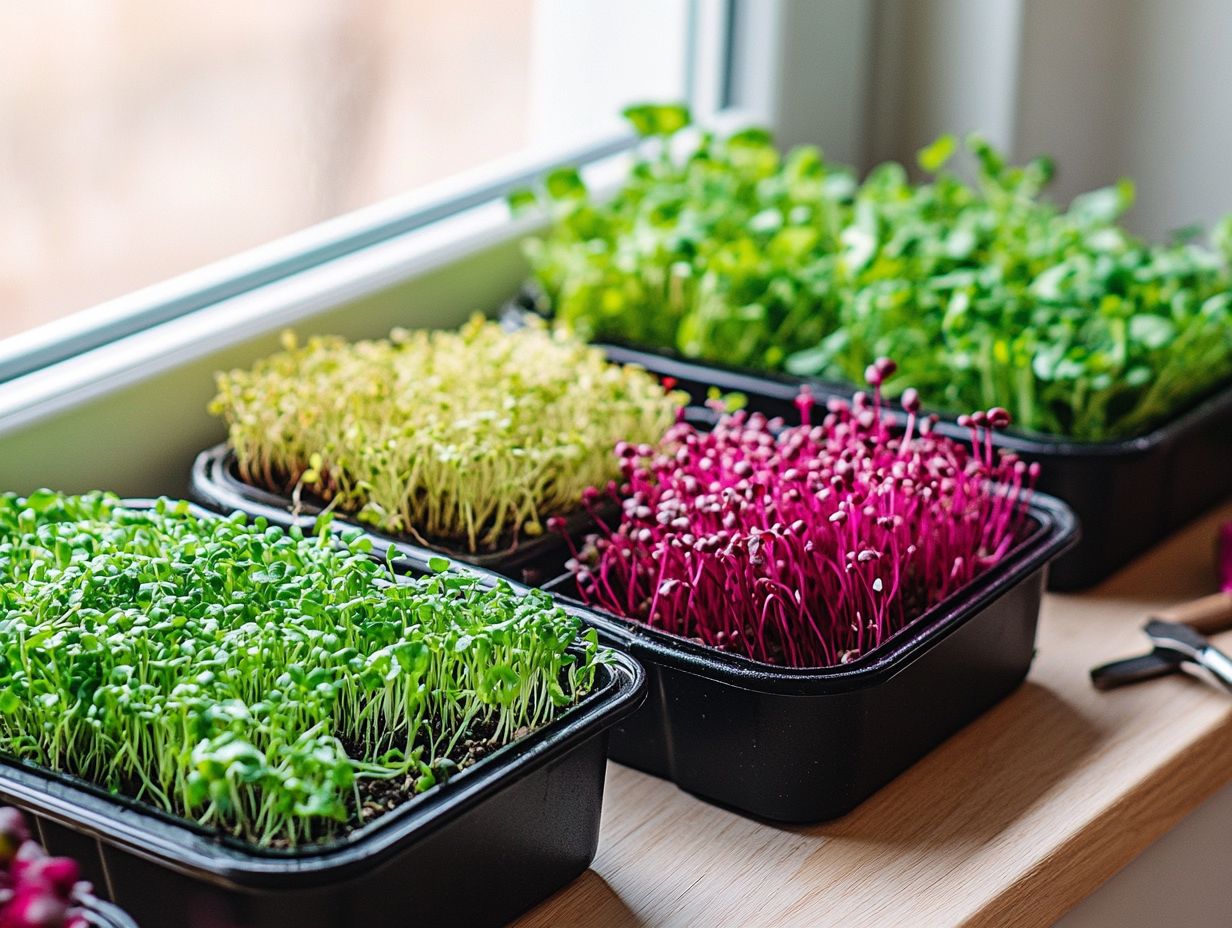
Incorporating microgreens into your cooking elevates the flavor of your dishes and enriches their nutritional profile. They infuse meals with a wealth of antioxidants and essential vitamins A, C, K, and E, which are vital for a balanced diet.
Imagine transforming a simple Buddha bowl into a nutrient-packed masterpiece. A handful of pea shoots enhances its visual allure and adds a delightful subtle sweetness, making it perfect for anyone focused on weight management.
For your soups, garnish with a sprinkle of sunflower microgreens. They are rich in vitamin E and support skin health while combating oxidative stress.
Even your sandwiches can achieve new heights with the addition of radish or arugula microgreens. They deliver a peppery kick and an abundance of vitamins that promote overall wellness. This versatility makes microgreens a straightforward yet powerful way to elevate your meals.
5. Sell Your Microgreens to Local Restaurants or Farmers Markets
Sell your microgreens at local restaurants or farmers markets for an exciting and rewarding adventure! You’re not just offering delicious greens; you’re sharing the benefits of plant-based nutrition with your community while supporting sustainable agriculture and healthier food choices.
To thrive in this endeavor, establish meaningful connections with local chefs and market vendors. Engaging with chefs opens opportunities for collaboration and provides valuable insights into menu trends.
Regularly visiting farmers markets allows you to gather firsthand knowledge about competitor pricing strategies. You will learn how to effectively market your microgreens as nutrient-dense options.
Investing time in branding your microgreens is crucial for creating a memorable identity that resonates with customers. Highlight their health benefits, like being rich in antioxidants, and showcase their versatility in various culinary applications from salads to garnishes.
This approach allows your microgreens to shine in any kitchen, capturing both attention and taste buds.
What Are Microgreens? Discover Their Benefits!
Microgreens are young, edible plants harvested just after the first true leaves appear. They’re packed with a concentrated array of nutrients and health benefits, making them a powerful addition to your diet. They promote wellness and boost the nutritional value of your meals.
Typically harvested within two to three weeks after germination, these tiny greens can be grown from various plant species, including herbs, vegetables, and some grains. Rich in antioxidants, vitamins, and minerals, microgreens support immune function and overall health.
Their vibrant colors and distinctive flavors enhance the visual appeal of your dishes. They provide a concentrated source of plant-based chemicals that benefit health, potentially helping to reduce inflammation and protect against chronic diseases.
Incorporating them into your salads, smoothies, or sandwiches can elevate both taste and nutrition. This benefits anyone looking to enhance their dietary routines.
Try incorporating microgreens into your next meal for an instant flavor and nutrition boost!
What Are Some Common Types of Microgreens?
Some common types of microgreens include varieties like broccoli, radish, kale, arugula, cilantro, and basil. Each of these adds unique flavors and impressive health benefits, enhancing your meals and supporting a nutrient-dense diet.
Broccoli microgreens bring a subtle, nutty flavor and are packed with sulforaphane, a compound known for its cancer-fighting properties. Radish microgreens add a peppery bite, perfect for salads and sandwiches, while delivering a healthy dose of vitamins C and E.
Kale microgreens have a hint of sweetness and are rich in antioxidants, making them an excellent choice for smoothies or as a topping. Arugula adds zesty notes that enhance your dishes, contributing valuable nutrients like calcium and iron.
Cilantro and basil add fresh herbal flavors, enriching cuisines worldwide while offering essential oils and vitamins that support overall health. These vibrant microgreens not only make your dishes pop, but they also pack a flavorful punch!
How Can You Grow Microgreens Indoors?
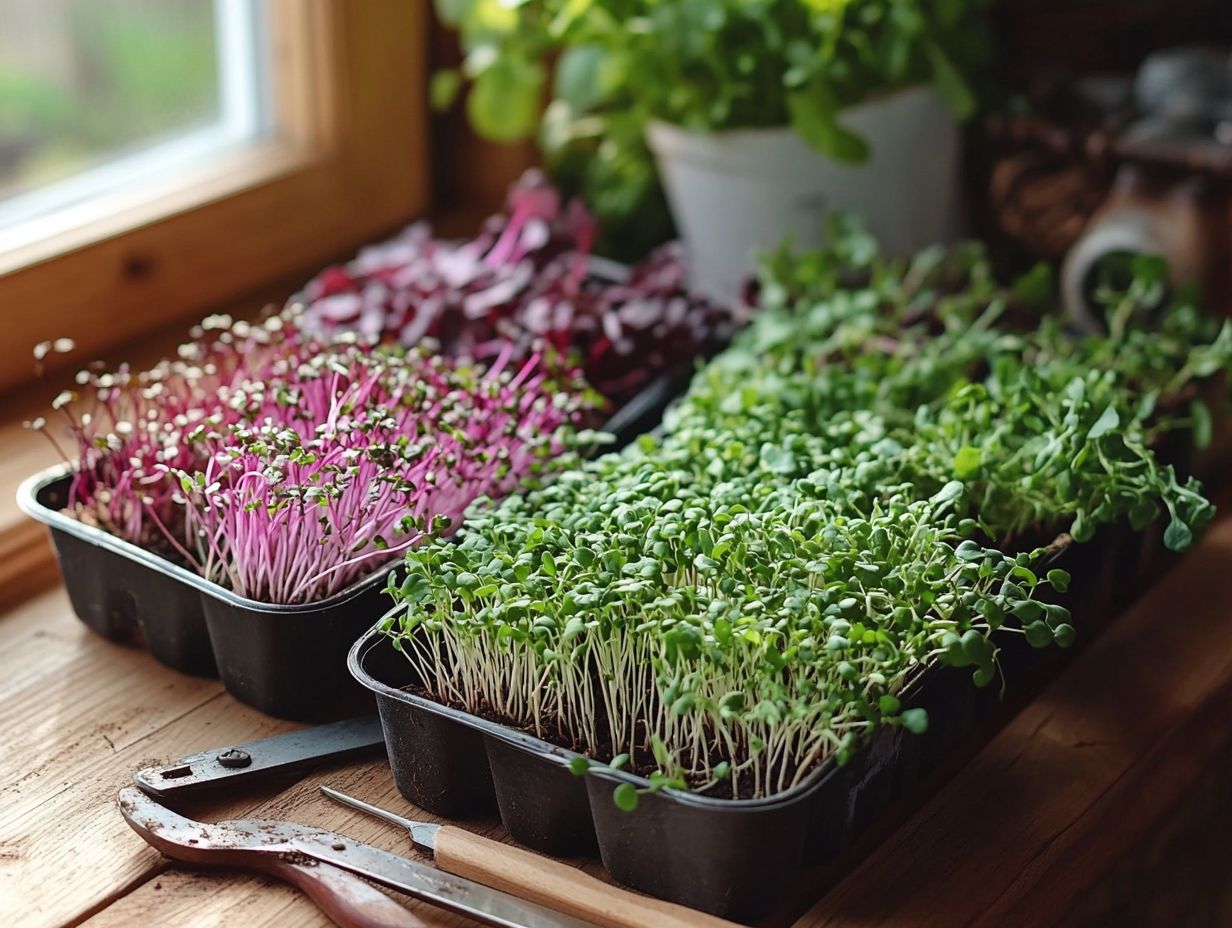
Growing microgreens indoors is a rewarding endeavor that allows you to enjoy fresh produce year-round. With a simple germination process and the right soil medium, you can create optimal conditions for growth.
Follow these essential steps to cultivate these nutritious greens without needing extensive gardening experience:
-
Select a high-quality soil medium that retains moisture while offering excellent drainage. This balance is crucial for nurturing healthy roots.
-
Pay attention to your watering techniques. Mist the soil gently with water until it s moist but not soggy, creating an ideal environment for sprouting.
-
Lighting plays a vital role. Place your microgreens in a sunny window or under grow lights to encourage robust growth.
-
Once the seeds have germinated, regular care is essential. Monitor moisture levels and provide consistent lighting to ensure your indoor garden flourishes beautifully.
What Are the Best Growing Conditions for Microgreens?
The optimal conditions for growing microgreens depend on three key factors: adequate light, the right temperature, and a suitable growing medium, whether soil or water without soil. These elements work together to cultivate thriving plants that can aid in weight management and enhance overall health.
To unlock their full potential, ensure your microgreens receive the right light exposure. Most varieties thrive under bright, indirect sunlight or artificial grow lights for about 12 to 16 hours each day. Temperature is also crucial; keeping it between 65 to 75 degrees Fahrenheit is generally ideal, as extremes can hinder germination and growth. Following essential tips for growing microgreens at home can further enhance your success.
Humidity levels are important too, with a range of 40% to 70% being optimal for the moisture conditions that root systems prefer. The choice of growing medium can influence growth rates and nutrient density. For example, hydroponic systems often yield quicker growth with potentially higher nutrient content, while traditional soil might provide a more balanced habitat for certain microgreen varieties.
How Long Does It Take to Grow Microgreens?
Growing microgreens is a quick process, typically taking only 7 to 21 days from seed to harvest, depending on the variety and the conditions you provide during germination.
Temperature, humidity, and light exposure are crucial factors that can accelerate or extend the growth cycle. For instance, warmer temperatures paired with adequate light can significantly boost growth rates, making it essential to maintain an optimal environment.
When it comes to harvesting, aim for the window just before the true leaves start to emerge. This is when the flavors are most concentrated, and the nutrient profile reaches its peak.
By regularly checking on your microgreens, you can ensure they re harvested at just the right moment to maximize both taste and health benefits.
Ready to enjoy the benefits of microgreens? Start growing your own today and elevate your meals!
What Are Some Common Mistakes When Growing Microgreens?
Many beginners stumble into common pitfalls when growing microgreens. These include improper watering, insufficient light, and choosing the wrong soil medium.
Such issues may lead to stunted growth or, worse, complete crop failure. This is particularly true if you’re unaware of the ideal conditions these delicate plants require.
To cultivate a thriving microgreen garden, establishing a reliable watering schedule is essential. Keeping the soil consistently moist without becoming waterlogged is crucial.
Invest in grow lights made just for microgreens! They can save your greens during those cloudy days. Opting for a well-draining soil mix enriched with organic matter will promote healthy root development and nutrient absorption. This sets the stage for a successful harvest.
Frequently Asked Questions

What are microgreens?
Microgreens are young, edible greens that are harvested a few weeks after sprouting from seeds. They are packed with nutrients and come in a variety of flavors and textures.
Why should I grow microgreens?
Growing microgreens at home is easy, cost-effective, and provides you with fresh, healthy greens all year round. They are also an excellent addition to salads, sandwiches, and smoothies.
What are the best containers to use for growing microgreens?
You can use a variety of containers to grow microgreens, such as shallow trays, seedling trays, or even repurposed plastic containers.
Just make sure they have drainage holes and are at least 2-3 inches deep.
Can I use any type of soil to grow microgreens?
No, it’s best to use a sterile, lightweight potting mix or a soilless growing medium (a mix without soil) specifically designed for microgreens. These will provide the right balance of nutrients and allow for proper root growth.
What are some creative ways to grow microgreens?
- Use a vertical garden system.
- Grow them in a mason jar or other glass container.
- Create a hanging microgreen garden.
- Use a hydroponic system.
- Use a windowsill planter with built-in LED lights.
How long does it take for microgreens to grow?
Microgreens typically take 1-2 weeks to grow, depending on the variety. Some greens like broccoli and radish will grow faster, while others like sunflowers and peas may take a bit longer.

